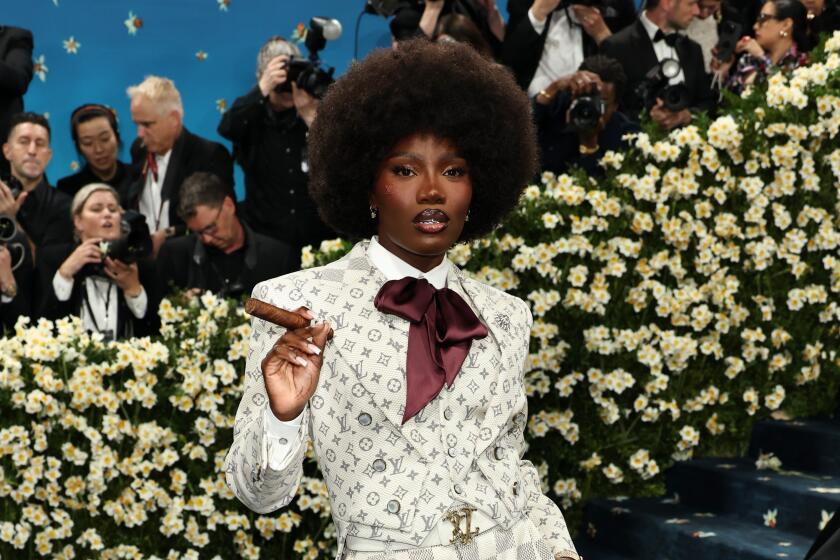Ottinger’s ‘Dorian Gray’ a Surreal Adventure
- Share via
“The Films of Ulrike Ottinger” continues Thursday at 8 p.m. in UCLA’s Melnitz Theater with “The Image of Dorian Gray in the Yellow Press.” It is a taxing but constantly imaginative 150-minute adventure into the surreal made by the well-known German lesbian/feminist filmmaker, who will appear in person.
A multinational newspaper magnate significantly named Frau Dr. Mabuse (the late Delphine Seyrig at her wittiest) lures a naive, indolent young man named Dorian Gray (fashion model Veruschka von Lehndorff) into becoming the subject of an ongoing series of sensational tabloid stories.
Ottinger may be criticizing the manipulative and exploitative media, but she seems more interested in exploring the possibilities of Post-modern design in a series of boldly inventive tableaux. Her film becomes an odyssey, involving a journey through a Dante-esque underworld and even includes an avant-garde opera. The UCLA Film Archive, the Goethe Institute and the Gay & Lesbian Media Coalition are presenting the Ottinger series.
Information: (213) 206-FILM, (213) 206-8013.
Louis Malle’s rarely revived 1976 “Black Moon” screens Thursday at 7 p.m. at USC’s Taper Hall of the Humanities, Room 101, as the final film in the “Mystery and Magic” series. Certainly Malle’s most challenging and surreal film, it’s an exquisite, often nightmarish and mainly perplexing fantasy. Yet it is also an enormously tantalizing and oddly compelling film that invites us to respond to it intuitively.
It seems that the Trojan Wars (!) are being fought not far from a superb old French provincial manor house where an English girl (Cathryn Harrison) seeks refuge with a bizarre old lady (Therese Giehse). Other members are the household are Joe Dallesdandro, who sings Wagner while pruning trees, and the beautiful Alexandra Stewart, who hums a lot but says nothing.
Starting with the appearance of a unicorn--the ever-elusive symbol of chastity and purity, a creature who can only be loved by a virgin--Malle draws upon an array of archetypal figures and situations to evoke most powerfully a feeling of life’s essential mystery. Decrying war and cherishing nature, Malle presents the entire spectrum of human behavior; only art, he seems to be saying, can make sense of life’s absurdities.
Information: (213) 743-2666.
The UCLA Film Archive’s comprehensive “A Season of New Zealand Films” continues Saturday at 7:30 p.m. with “Ngati” (1987), an awkward but nevertheless remarkable evocation of what day-to-day life is like for two races living side by side. Key characters develop abruptly, solutions to centuries-old problems seem pat, actors on occasion seem nakedly amateurish, yet these drawbacks are more than compensated by director Barry Barclay and writer Tama Poata’s ability to illuminate the complexities and contradictions of interracial relationships.
That the Anglos and the Maoris who inhabit the idyllic bay-side ranching community of Kapua live by and large harmoniously with a marked degree of mutual respect and affection does not prevent an almost unconscious but stifling paternalism on the part of many whites that chronically undermines the Maoris’ self-esteem and self-confidence. The entire thrust of the film is to argue persuasively (but not heavy-handedly) that self-determination on the part of the Maoris is good for everyone--it’s even good for the economy. It suggests further, however, that like all other minorities the Maoris themselves must start the process of self-assertion.
The time is 1948, and the story is set in motion by the arrival of a young physician (Ross Girven), born in Kapua but raised and educated in Australia. The community’s economy is imperiled by the closure of the local freezing plant, which in the past had a monoply on the needs of the local cattle and sheep ranchers. On a more timeless level, Kapua is responding a Maori boy dying of leukemia. There is lots more going on in this 90-minute movie, and forgivably the filmmakers get carried away by the ethnographic, recording Maori customs, when they should be concentrating more on the dramatic. It’s worth noting that this thoughtful film is a production of John O’Shea’s trailblazing Pacific Films.
“Ngati” will be followed by John Liang’s “Other Halves” (1984), an interracial romance. Sunday’s 7:30 p.m. offering is “Treasures From the New Zealand Film Archive.”
Information: (213) 206-FILM, 206-8013.
More to Read
The biggest entertainment stories
Get our big stories about Hollywood, film, television, music, arts, culture and more right in your inbox as soon as they publish.
You may occasionally receive promotional content from the Los Angeles Times.










